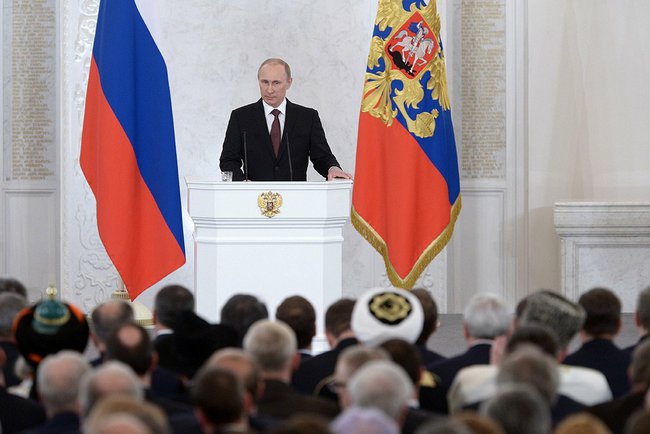In order to understand why Putin invaded Ukraine, we need to attempt to see into the mind of this former KGB colonel. Vladimir Putin believes that the West wants his overthrow—just as occurred in Kiev to former President Yanukovych. He hates NATO and what he firmly believes are its attempts to encircle Russia, including offering membership to Ukraine. Putin has a deep sense of the loss of the power and prestige of the former Soviet Union. And he has an acute belief of Russia’s need to protect its citizens living in ‘the near abroad’ in former Soviet possessions. These are the key issues that motivated him to annex Crimea.
Putin states that the West has deceived Russia by the expansion of NATO to its very borders. Estonia, Latvia and Lithuania are members of NATO, as are Poland, Bulgaria and Romania. If Ukraine were to join the EU, and inevitably NATO, this would put NATO forces within 400 km of Moscow. NATO expansion has resulted in Russia losing huge areas of territory flanking its western approaches, a traditional invasion route. Putin will absolutely not accept Ukrainian membership of NATO.
The Russian naval base at Sebastopol in the Crimea is vital for the access of Russia’s Black Sea Fleet to the Mediterranean. Without it, the Russian navy would have to rely upon its St Petersburg based Baltic Fleet and passage through the Baltic Sea, which is dominated by NATO countries such as Germany, Poland and Norway. Putin could not tolerate a pro-Western government in Kiev denying him this crucial military asset in Crimea.
Also, there are ancient cultural and religious ties between Russia and Ukraine; Kiev is where Russian Christianity began over 1000 years ago. Putin describes it as ‘the mother of Russian cities’. The Russians call their fellow Slavs in Ukraine ‘Little Russians’ and Solzhenitsyn observed that all Russians have some Ukrainian blood. The eastern part of Ukraine is predominantly Russian speaking, Russian Orthodox religion and industrialised, whereas the western part of Ukraine is predominantly Ukrainian speaking, Catholic and rural. Ethnic Russians account for 40% of the population in eastern Ukraine and almost 60% of the population in Crimea.
Poland dominated western Russia for a long time; in the early 1600s, in a period known as ‘the time of troubles’ (smutnoe vremya), a Polish army from Lvov invaded Moscow and sought to place a pretender on the tsar’s throne. This was a time of great social and political upheaval for Russia, which faced uncertainty about its very existence. Many Russians see parallels with this in the upheavals of post-Soviet Russia. Putin’s suspicious mind undoubtedly sees meddling by Poland in the overthrow of Yanukovych and the presence of the Polish Foreign Minister Sikorskii in Kiev.
The issue of Ukraine and Crimea is central to Russians’ identity of themselves. That’s why Putin promised to take all possible measures to defend Russian citizens and reserves the right to use force to protect Russia’s interests in Ukraine. Although he has stated he won’t use military force against Ukraine itself, that remains to be seen. He’s likely to use all the powers of Russian state security organs to foment instability and insurrection in the name of protecting Russian citizens living in Ukraine. And there’s a risk of him seizing the eastern part of Ukraine if upheaval there allegedly threatens the lives of Russians.
Putin’s standing as a strong leader in the Russian tradition has grown enormously as a result of this crisis. He received numerous standing ovations during his speech in the Kremlin last week and in the celebrations in Red Square to mark the return of Crimea there were frequent calls of ‘Glory to Putin’. The annexation of Crimea has huge support among the Russian people, including former leader Gorbachev.
None of this is in any way to approve of Putin’s belligerence and what it means for the future of an independent Ukraine. But unless we understand what’s inside Putin’s head, the West will continue to be surprised by his actions. He won’t be fazed by sanctions, which he’ll simply stare down. And he’ll seek to drive wedges between America and European countries that are heavily dependent upon Russia for energy supplies, such as Germany. Putin’s popularity is at an all-time high and he’s very much in charge—driven by his view of what Russia should be.
I don’t accept that all this implies we’re returning to the dangers of the Cold War. But it does mean the view in the West that state-on-state conflict is an obsolete idea is no longer tenable. Europe, in particular, needs to relearn the fact that the use of force majeure by the dominant regional power has returned. Putin’s response to European appeals for him to recognise the sanctity of international borders is to sarcastically cite how the EU encouraged Kosovo to separate from Serbia, another Slavic country. He has also noted how, in his view, America ignored international borders in its own invasions of Iraq, Afghanistan and Libya.
Any idea of bringing Russia into the community of democratic nations is now dead. And we can’t rule out the further use of Russian military force in eastern Ukraine. Moreover, we’re seeing an understandable reluctance by America to confront a nuclear-armed Russia.
For Australia, there’s little we can do other than condemn this blatant act of aggression and join any sanctions the West imposes. But we need to factor into our calculations that authoritarian countries like Russia and China are flexing their muscles and won’t necessarily abide by the norms of international behaviour. Resisting coercion, whether Russian or Chinese, should be an important element in our new strategic thinking.
Paul Dibb is emeritus professor of strategic studies at The Australian National University. Image courtesy of the Russian Presidential Press and Information Office.


